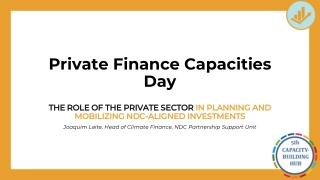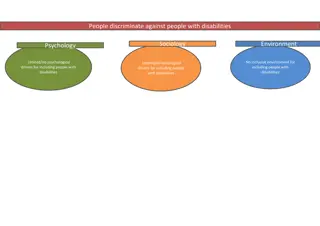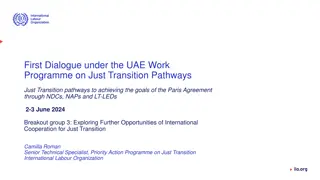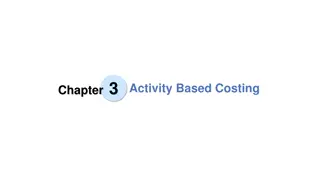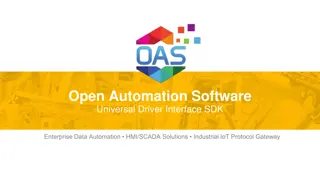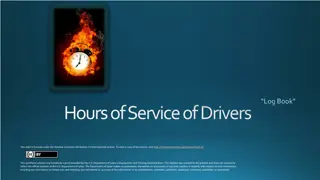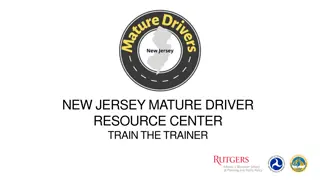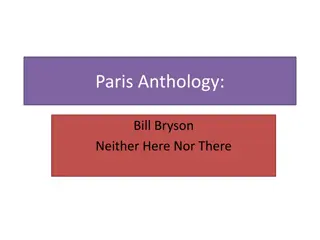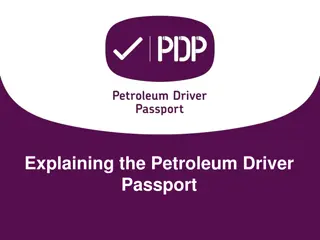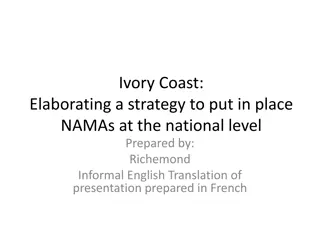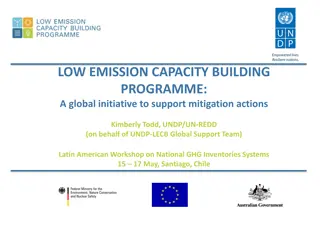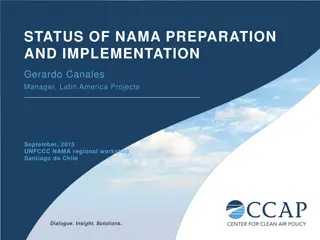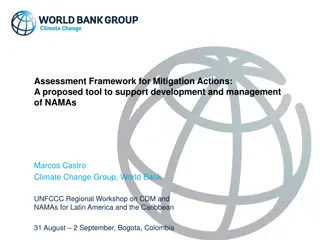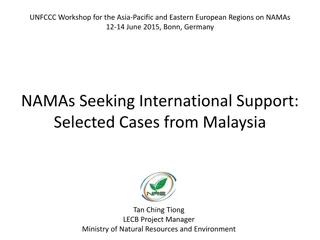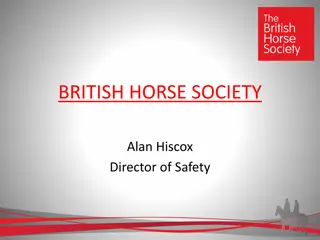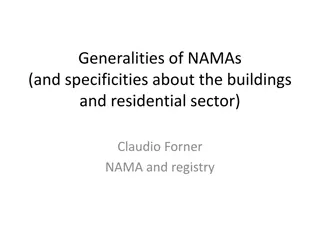Implementing NDCs Through NAMAs: Drivers, Needs & Opportunities
This content discusses Nationally Appropriate Mitigation Actions (NAMAs) as a vehicle to implement Nationally Determined Contributions (NDCs), highlighting success factors, guiding questions, and lessons from the Clean Development Mechanism (CDM). It covers the role of NAMAs in achieving sustainable development and emission reduction commitments, emphasizing governance structures, MRV provisions, and the transition from Programmes of Activities (PoAs) to NAMAs. The importance of a participatory approach, QA/QC procedures, and CDM experience in NAMA development is also outlined.
Download Presentation

Please find below an Image/Link to download the presentation.
The content on the website is provided AS IS for your information and personal use only. It may not be sold, licensed, or shared on other websites without obtaining consent from the author.If you encounter any issues during the download, it is possible that the publisher has removed the file from their server.
You are allowed to download the files provided on this website for personal or commercial use, subject to the condition that they are used lawfully. All files are the property of their respective owners.
The content on the website is provided AS IS for your information and personal use only. It may not be sold, licensed, or shared on other websites without obtaining consent from the author.
E N D
Presentation Transcript
Nationally Appropriate Mitigation Actions (NAMAs) as Vehicle to Implement NDCs Drivers, Needs & Opportunities Alexandra Soezer Climate Change Technical Advisor UNDP LECB Programme NAMA Training June 16th-17th, 2016 St. Vincent 1
Outline Learning from the CDM Introduction to NAMAs NAMA success factors and guiding questions 2
What is CDM and NAMA What is CDM Assist Parties not included in Annex I to the Convention in achieving sustainable development and in contributing to the ultimate objective of the Convention, and to assist Parties included in Annex I in achieving compliance with their quantified emission limitation and reduction commitments under Article 3 of the Kyoto Protocol. emission reductions are real, measurable and verifiable, and additional to any that would occur in the absence of the project activity; What is NAMA : Nationally Appropriate Mitigation Actions by developing country Parties in the context of sustainable development, supported and enabled by technology, financing and capacity building, in a measurable,reportable and verifiable manner "aimed at achieving a deviation in emissions relative to business-as-usual emissions in 2020. 4
CDM Experience to Develop NAMA Governance Structure Accounting Structure (centralized system, registry) Methodological standards Comparable quality and fungible Ensure Environmental Integrity MRV provision and consistent MRV requirements Transparency and Independence. Participatory approach (local/global stake holder) QA/QC procedures on data quality 5
Steppingstone from PoA to NAMA Support implementation of Policy /Programme measure. Elements such as Definition of Eligibility criteria Project identification and inclusion Programme finance Setting boundaries MRV process Management structure Cross sectoral projects (urban built) Design and Implementation elements of PoAs (concept of CPA , Sampling approaches, data quality issues) 6
CDM MRV System Is internationally accepted Has a fully operational assessment apparatus Has accreditation system for third party validators/verifiers Has registry for issuing and tracking credits Is used across the world as the source of rules for mitigation activities Enjoys a unique political legitimacy 7
NAMA Concept Creation The Bali Action Plan at 13th Conference of Parties (COP) to the Kyoto Protocol (2007) decided that: Nationally appropriate mitigation actions (NAMAs) are to be undertaken by developing country Parties in the context of sustainable development, supported and enabled by technology, financing and capacity building, in a measurable, reportable and verifiable (MRV) manner. 9
Further key decisions regarding NAMAs Copenhagen Accord (2009) Introduced the term supported NAMA to refer to NAMAs seeking international support for their implementation Stated that supported NAMAs should be subject to internationally agreed MRV standards Cancun Agreement (2010) developing country Parties will take nationally appropriate mitigation actions aimed at achieving a deviation in emissions relative to business as usual emissions in 2020 , but that developed country Parties shall provide enhanced financial, technological and capacity building support for the preparation and implementation of nationally appropriate mitigation actions of developing country Parties 10
Objective of NAMAs NAMAs Sectoral Approaches Strategies Programs Projects Aligned with country s national development plans & strategies Achieve GHG emission reductions Sustainable development impact Monitored, reported and verified (MRV) Government coordinated, but involves private sector, civil society organizations, academia, etc. 11
NAMA registry UNFCCC launched in 2012 an online NAMA registry to record NAMAs seeking international support and facilitate matching of finance, technology and capacity development 12
NAMAs within a countrys development strategy and the UNFCCC process Strategic level Tactical level Operational level Low Carbon Development Strategies Nationally Determined Contributions Nationally Appropriate Mitigation Action 13 Source: NAMA guidebook 2016
Status of NAMAs Globally Caribbean?? 14 Source: Tilburg et al., 2015, Status Report on Nationally Appropriate Mitigation Actions Mid-year update 2015.
Country Needs: Preparing & Implementing NAMAs Source: KPMG, 2011 15
Country Needs: Preparing & Implementing NAMAs Political Enabling environment for investment Institutional Guidance and staff capacity to prepare NAMAs NAMA coordination and managing authorities Outreach activities and liaising with donors & investors Established public promotion of public-private partnerships Capacity Building private dialogue & NAMA Technical National established MRV system in place, operational and well maintained NAMA progress and results regularly reported Technical Implementing Entity Finance Technology Financial Effective allocation of funds Promoting investment opportunities Promoting public finance mechanisms to catalyze private investment flows. 16
1. Identify a Champion to drive the NAMA development process 2. Stakeholder engagement (continuous, transparent, inclusive) 3. Political commitment to meet mitigation & development targets Identify lead institutions/ministries to coordinate and ensure continued buy-in 4. Promote local technical capacity - to ensure lasting technical support during NAMA and MRV system preparation 5. Identify a national financial institution - to manage large amounts of funds for effective allocation of financial resources 6. Put the private sector center stage engage in dialogues, encourage policy frameworks to facilitate investment in ventures under the NAMA framework 18
Is a leading institution identified that will drive the NAMA preparation process? Is the proposed NAMA a political priority, having full support from the key Ministries, and is aligned to national policies (INDCs)? Is there financial commitment for the future implementation of the NAMA? Does a national FI exist that will effectively allocate national and international financial resources and transparently monitor the financial support obtained? Is an institution identified that will lead the MRV of GHG ERs and SD impacts? Can the private sector get engaged in a dialogue and is there interest to invest in potential NAMA ventures? 19
Summary NAMAs are a tool that can help countries achieve reach their mitigation targets and longer-term national objectives development Opportunities development partners to support the Caribbean region implementing NAMAs for J-CCCP and other in preparing and 20
Thank you! Alexandra Soezer Climate Change Technical Advisor UNDP LECB Programme Alexandra.soezer@undp.org 21


